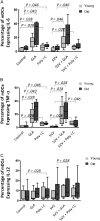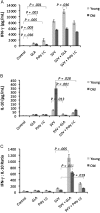GLA-SE, a synthetic toll-like receptor 4 agonist, enhances T-cell responses to influenza vaccine in older adults
- PMID: 22147791
- PMCID: PMC3256953
- DOI: 10.1093/infdis/jir769
GLA-SE, a synthetic toll-like receptor 4 agonist, enhances T-cell responses to influenza vaccine in older adults
Abstract
Background: The decline in influenza vaccine efficacy in older adults is associated with a limited ability of current split-virus vaccines (SVVs) to stimulate cytotoxic T lymphocyte (CTL) responses required for clinical protection against influenza.
Methods: The Toll-like receptor 4 agonist glucopyranosyl lipid adjuvant-stable emulsion (GLA-SE) was combined with SVV to stimulate peripheral blood mononuclear cells (PBMCs) in vitro to determine the cytokine response in dendritic cell subsets. Stimulated PBMCs were then challenged with live influenza virus to mimic the response to natural infection following vaccination, using previously identified T-cell correlates of protection.
Results: GLA-SE significantly increased the proportion of myeloid dendritic cells that produced tumor necrosis factor α, interleukin 6, and interleukin 12. When combined with SVV to stimulate PBMCs in vitro, this effect of GLA-SE was shown to regulate a T-helper 1 cell response upon challenge with live influenza virus; interleukin 10 production was suppressed, thus significantly increasing the interferon γ to interleukin 10 ratio and the cytolytic (granzyme B) response to influenza virus challenge, both of which have been shown to correlate with protection against influenza in older adults.
Conclusions: Our findings suggest that a novel adjuvant, GLA-SE, combined with standard SVV has the potential to significantly improve vaccine-mediated protection against influenza in older adults.
Figures



Similar articles
-
Improved Immune Responses in Young and Aged Mice with Adjuvanted Vaccines against H1N1 Influenza Infection.Front Immunol. 2018 Feb 19;9:295. doi: 10.3389/fimmu.2018.00295. eCollection 2018. Front Immunol. 2018. PMID: 29515589 Free PMC article.
-
Synthetic Toll-like receptor 4 (TLR4) and TLR7 ligands as influenza virus vaccine adjuvants induce rapid, sustained, and broadly protective responses.J Virol. 2015 Mar;89(6):3221-35. doi: 10.1128/JVI.03337-14. Epub 2015 Jan 7. J Virol. 2015. PMID: 25568203 Free PMC article.
-
Immunologic correlates of protection and potential role for adjuvants to improve influenza vaccines in older adults.Expert Rev Vaccines. 2013 Jul;12(7):759-66. doi: 10.1586/14760584.2013.811193. Expert Rev Vaccines. 2013. PMID: 23885821 Review.
-
Molecular and cellular response profiles induced by the TLR4 agonist-based adjuvant Glucopyranosyl Lipid A.PLoS One. 2012;7(12):e51618. doi: 10.1371/journal.pone.0051618. Epub 2012 Dec 28. PLoS One. 2012. PMID: 23284726 Free PMC article.
-
IL-18 and Subcapsular Lymph Node Macrophages are Essential for Enhanced B Cell Responses with TLR4 Agonist Adjuvants.J Immunol. 2016 Dec 1;197(11):4351-4359. doi: 10.4049/jimmunol.1600993. Epub 2016 Oct 28. J Immunol. 2016. PMID: 27794001 Free PMC article.
Cited by
-
Trial Watch: Peptide-based anticancer vaccines.Oncoimmunology. 2015 Jan 9;4(4):e974411. doi: 10.4161/2162402X.2014.974411. eCollection 2015 Apr. Oncoimmunology. 2015. PMID: 26137405 Free PMC article. Review.
-
Exploiting the critical perioperative period to improve long-term cancer outcomes.Nat Rev Clin Oncol. 2015 Apr;12(4):213-26. doi: 10.1038/nrclinonc.2014.224. Epub 2015 Jan 20. Nat Rev Clin Oncol. 2015. PMID: 25601442 Free PMC article. Review.
-
Vaccine self-assembling immune matrix is a new delivery platform that enhances immune responses to recombinant HBsAg in mice.Clin Vaccine Immunol. 2015 Mar;22(3):336-43. doi: 10.1128/CVI.00714-14. Epub 2015 Jan 21. Clin Vaccine Immunol. 2015. PMID: 25609075 Free PMC article.
-
Influenza vaccine-mediated protection in older adults: Impact of influenza infection, cytomegalovirus serostatus and vaccine dosage.Exp Gerontol. 2018 Jul 1;107:116-125. doi: 10.1016/j.exger.2017.09.015. Epub 2017 Sep 27. Exp Gerontol. 2018. PMID: 28958701 Free PMC article. Clinical Trial.
-
Vaccine strategies to enhance immune responses in the aged.Curr Opin Immunol. 2013 Aug;25(4):523-8. doi: 10.1016/j.coi.2013.05.014. Epub 2013 Jun 10. Curr Opin Immunol. 2013. PMID: 23764092 Free PMC article. Review.
References
Publication types
MeSH terms
Substances
Grants and funding
LinkOut - more resources
Full Text Sources
Other Literature Sources
Medical

